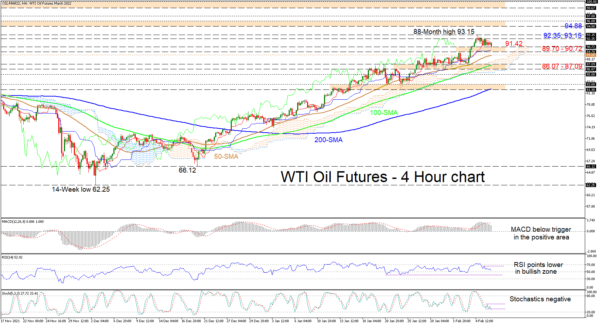WTI oil futures have stabilized, tiptoeing across the 89.70-90.72 support barrier after a pullback from the near 7½-year high of 93.15. The soaring simple moving averages (SMAs) are safeguarding the broader positive structure despite the minor retreat in the price of the black liquid.
The Ichimoku lines suggest guiding forces have fairly dried up, while the short-term oscillators are reflecting a slight weakening in the positive momentum. The MACD, some distance above zero, is fading below its red trigger line, while the falling RSI is nearing the 50 neutral threshold. The revived negative charge of the stochastic oscillator is promoting downside moves in the commodity.
In the negative scenario, downside limitations could come from the immediate 89.70-90.72 barrier, encompassing the flattening blue Kijun-sen line. Approaching from beneath this obstacle is the 50-period SMA at 89.05, which may try to provide footing for buyers to capitalize on. However, if a deeper price retracement unfolds, the Ichimoku cloud could operate as a tough support zone as it surrounds the 86.07-87.09 border, which is fortified by the 100-period SMA. Successfully driving the price lower, sellers may then attempt to accelerate negative moves with a break of the 85.00 handle.
Alternatively, if buyers find some traction from the 89.70-90.72 instant support, they could meet preliminary upside friction from the red Tenkan-sen line at 91.42 ahead of the 92.35 and 93.15 nearby highs, the latter being the more than 7-year high. Reviving the one-and-a-half-month rally from the 66.12 level, the bulls may then target the 94.88-96.00 resistance band formed by the September and August 2014 highs. Overstepping this, the 97.00 hurdle could then impede advances from gaining pace.
Summarizing, WTI oil futures are exhibiting a bullish bias above the 89.70-90.72 support and the climbing SMAs. That said, for negative tendencies to significantly gain strength, the price would need to glide below the cloud, which encapsulates the 86.07-87.09 upside defence.













